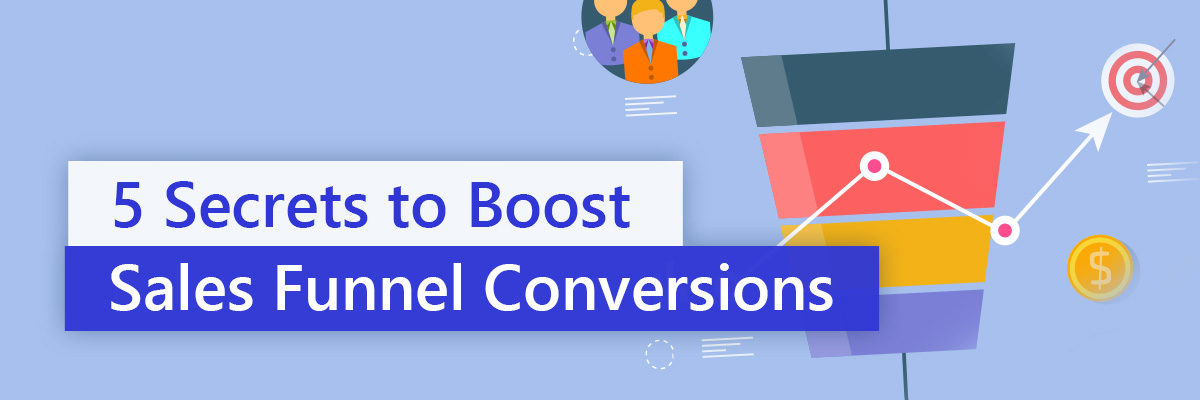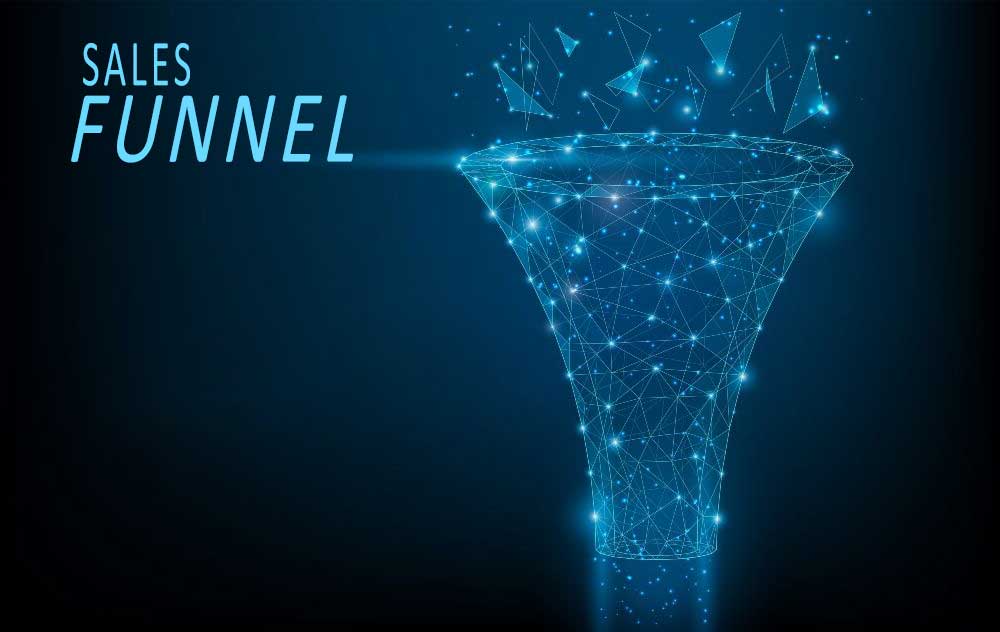5 Secrets of Successful Sales Funnel Conversions

Whether you're a small business operating alone or a large multinational corporation with thousands of employees, if you want to turn more website visitors into loyal customers, you have to examine your sales funnel.
As more and more SMB's take on the role of sole owner, operator, chief marketer, and so much more, the importance of establishing your sales funnel is essential to maximize your marketing budget and efforts. Whether you're making your own webstore or running a brick-and-mortar business, it's important to consider the customer journey from awareness to paid customers and even advocate for your business.
- Stick to Your Niche
- Know Your Entry Points
- Testing
- Conversion-Focused Content
- Landing Pages
- Conclusion: Enhance Your Sales Funnel with CyberLink
What is a Sales Funnel?
You may be wondering, "What is a sales funnel, anyway?" A sales funnel helps you visualize the stages your potential customers go through before deciding whether or not to make a purchase. The funnel becomes narrower toward the bottom as only the most engaged prospects progress to each phase of the buying process.
A funnel typically includes some variation of the following steps:

- Awareness
- Consideration
- Preference
- Purchase
- Loyalty
- Advocacy
Each step involves several digital marketing tactics that you can employ to engage your prospects. As a small business, focusing on this funnel will ensure you can expand your reach to prospective customers and maximize the number of customers you can convert. With the right funnels in place, you can be sure you are increasing your visibility while cultivating strong new leads along the way.
As SMB owners take on more roles for their business than ever, new tools are emerging to make the process of developing a sales funnel that is streamlined for any level of experience or budget. For example, check out our ultimate guide to creating marketing videos for your business—marketing videos can be effective on virtually any stage of your sales funnel when used correctly.
With tools like PowerDirector Business 365 and the mobile Promeo app , it is now possible for small businesses to optimize each stage of their funnel with effective video marketing. Social media ads, landing pages, product pages, email campaigns, search engine marketing, conversion-focused content, and other mediums also play a role in targeting your medium and message for each stage of your potential customers' journey on their way to becoming a loyal customer. As an example, video is one of the most powerful mediums for marketing on these channels and with these tools, even a single person can become a full video production team in minutes.
The tips in this article will show you how to create a sales funnel that captures new prospective customers and drives them to convert into paying customers. Let's dive right in!
1. Stick to Your Niche
No matter how well you design your entry points, they won't bring you any business if you're targeting the wrong audience. For the most effective conversions, you need to carve out a specific niche in the market.

Who Is Your Customer?
Picture the ideal customer for your product or service, and don't be afraid to get specific regarding their attributes and goals. Targeting a certain type of person will bring in more customers than casting a wide net.
We recommend creating 'customer avatars', also known as ‘personas', which are fictional characters that represent your ideal customer. In these profiles, you can refine details of your ideal customer to develop a clear perspective of who they are and what motivates them.
What Is the Issue They Have?
When thinking about your niche and your avatars, it's important to consider the customer's pain points. What are their challenges? What are the pain points that your product or service can address. Identify their needs that aren't being met by other companies out there and that gives you a unique position in your market.
How Do You Solve It?
If you frame your product or service in the context of the problem your customer is facing, your customer will have a stronger reason to buy it. Think about the ways in which your business can address the issue. That's the unique selling proposition that will drive your sales.
Focus on What They Need
Giving customers what they need will always work better than trying to convince them to want what you're selling. Market research will help you determine what your potential customers are searching for.
2. Know Your Entry Points
In today's digital age, the channels for drawing in customers are virtually endless—it can make your head spin. But in general, entry points into your website come from a few main sources:

Search Engine
Even a small fish in a big pond can be discovered on search engines with the right content. Using great copy and content like videos greatly increases your marketing reach on search engines. An organic search on an engine like Google will lead customers directly to your website. Make sure you optimize your webpages with relevant keywords so that they'll rank higher in the search results.
Social Media
As a small business owner, social media is your window to the world of potential customers. Regularly interacting with your target audience on social media helps boost brand awareness and drum up brand loyalty. Of course, one of the best ways to reach new customers on social channels is to share an ad.
Whether you create a Facebook ad, Twitter ad, Instagram video ad, or Instagram story ad, your business ad should grab the viewer's attention. Eye-catching graphics—especially in an IG ad—and enticing offers will do the trick.
Paid Ad
Paying for advertising on blogs, vlogs, and YouTube videos can help attract customers. Pay-per-click (PPC) campaigns allow you to pay websites for sharing your ads with minimal risk; you may only have to pay whenever someone clicks on your business ad.
Promotional video advertising serves as an especially dynamic presentation of your business. Research video ad examples to gather ideas.
If you feel like you don't have the chops to create a compelling YouTube video ad, don't worry; a marketing video maker like CyberLink PowerDirector 365 Business or Promeo will provide you with business video templates, tons of royalty-free stock content and a drag-and-drop interface that will make video editing a breeze. These tools will enable you to create compelling video ads, often in less than 5 minutes.
Regular email blasts, as well as lead nurturing emails, will educate your prospects, build trust, and gently guide them toward making a purchase. A study by marketing automation company Eloqua revealed that personalized nurtured emails have a response rate four to ten times greater than generic emails. As a small business, creating this line of direct communication with your customers is essential in maintaining and cultivating your relationship with interested parties.
3. Testing
Figuring out what aspects of your marketing strategy are working and what aspects aren't is an essential step to patching up any holes in your sales funnel. For small businesses, maximizing return on investment is essential to your success. The best way to do this involves testing your webpages, ads, emails, etc., analyzing the data, and then implementing the results.
This process may sound daunting, but the insights you'll gain from the metrics will make it all worthwhile. As you start to get a better idea of what content and designs pull in more customers, you'll be able to create more effective marketing materials going forward.
A/B Test
If you don't take a look at how potential customers interact with your marketing materials, you're running your business blind. A/B testing can shed some much-needed light on the subject. Sometimes called split testing, A/B testing is a user experience research methodology that simply entails comparing two versions of something: A and B.
Randomly divide your audience in half—you don't want major variations between the two groups—and then show one half option A and the other option B. Keep both versions running for a few weeks in order to gather enough data on your customers' behavior.
You can A/B test virtually anything in your marketing sales funnel: a homepage, a product page, a landing page, a social media ad, a video—the list goes on. You may even want to test the nitty-gritty elements such as color schemes, fonts, slogans, calls to action (CTAs), etc.
Analyze Results
Once the roughly month-long testing period has finished, it's time to look at how your customers and potential customers reacted to versions A and B. Here are just a handful of metrics you should look for:
- Ad click-throughs
- Button clicks
- Email signups
- Video engagement
- Average time spent on site
Based on how versions A and B performed in these areas, you can determine which one is converting more viewers into customers.
Implement Findings
Now that you've discovered that, say, A leads to more conversions than B, you can remove version B from your website or social media account so that everyone sees only A.
However, your work isn't done here. Rather than testing all of these aspects merely once early on in your business, A/B testing should be an ongoing operation. Create an A/B testing calendar so that you know what area to work on next. That way, you'll always be improving something.
4. Conversion-Focused Content
By “content,” we're referring to all of the copywriting, images, and graphics on your webpages. You may have heard that content is king, but that only applies when the content works. Make sure your content addresses the appropriate audience and adequately describes your product or service.

- Relevant - discuss what you implied you'd cover in the webpage title
- Attractive - include visuals
- Interesting - include anecdotes to spice up your prose
- Easy to read - break paragraphs into smaller sections
- Easy to understand - no jargon
In addition your content needs to:
Acknowledge the Problem
A visitor came to your website for a reason. When you address the problem that your prospective buyer is facing, you immediately catch their interest.
Offer a Solution
Lead the prospect to the next phase of the funnel by showing how you can help fix their problem. What does your product do that your bigger competitors don't? What makes you unique? If you don't explicitly provide a unique solution, your prospective customer might not see the value in your small business versus a larger competitor.
Call to Action
What do you want the reader to do now? Whether you want the prospective buyer to schedule an appointment, join an email list, or make a purchase, your call to action needs to be clear and relevant to the content they just read. A CTA button usually makes the next step obvious.
Close
The Marketing Rule of Seven states that your prospective buyer needs to hear or see your marketing message at least seven times before they buy from you, so in addition to providing information, you need to actually make the ask—and make it often. Give your reader several opportunities to close the deal.
A Simple Solution
There's no sense in reinventing the wheel when it comes to implementing tried-and-true sales techniques. If you're not sure where to start in creating high-converting content, there's no better way than to work from a template.
With tools like PowerDirector for Business 365 and the Promeo mobile app , the sales pitch is already laid out for you with templates. All you have to do is select from one of the hundreds of templates and customize. Change a few lines of text and replace a few clips with your own footage or even select from an expansive stock library and you're ready to publish compelling video content that converts at any stage of your funnel.
5. Landing Pages
Also known as a lead capture page, a landing page contains content that addresses one particular problem with one particular CTA. The goal of a landing page is to capture your prospect's contact information or make a sale, so it's crucial that you get it right.

Be Specific
Unlike a general homepage, a landing page should be specific to a single product or service. By creating a specific landing page, you direct potential customers right to the information they need—and that you want them to see—instead of making them navigate your website in order to find it.
Entry-Based
Each landing page should be specific to the entry point the prospect came from, such as a Facebook ad or blog post. We've all clicked on a link expecting one thing but got led to something different, and it's frustrating. That's called customer disconnect, and you want to avoid it.
Designed to Finalize Sale
You must consider search intent—what a user is looking for and why they're looking for it—when directing prospects to a landing page. Your landing pages should cater to prospects with transactional intent—meaning they're ready to make a purchase—instead of those still in the research phase.
In order to close the sale, your landing page needs to reflect the mindset of your customer. In particular, make sure your CTAs tell the visitor to do exactly what they came to your page to do.
6. Conclusion: Enhance Your Sales Funnel with CyberLink

- Target a specific subset of customers, and stick to that niche.
- Search engines, social media, paid ads, and emails all serve as viable entry points to your website.
- Carry out A/B testing to learn what content draws more conversions.
- Focus your content on the conversion process, from acknowledging the problem to closing the sale.
- Use specific landing pages to help potential customers finalize the sale.
Related: How To Make Your Small Business Thrive Using Video Marketing

If you need some help creating engaging content for your sales funnel, CyberLink can help you out. Our business content creation tools are second to none when it comes to making video production easy and affordable. With the PowerDirector for Business 365 and the Promeo mobile app, you have access to pre-made marketing video templates and an easy-to-use interface for producing high-quality business videos. In addition to being a streamlined production platform for creative marketing videos, it also comes fully equipped with any tool you need to customize your videos. And with an expansive stock library paired with hundreds of diverse video templates, you can create marketing videos in just a few minutes without even filming a thing!
Download PowerDirector 365 Business for your desktop or Promeo for iOS or Android today and start publishing your video ads in minutes!.
If you found this article useful, why not venture over to our ultimate guide for video marketing? Our guide covers everything you need to know when creating ads or promotional videos for your brand or business.





